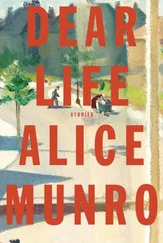Alice Munro - The Love Of A Good Woman
Здесь есть возможность читать онлайн «Alice Munro - The Love Of A Good Woman» весь текст электронной книги совершенно бесплатно (целиком полную версию без сокращений). В некоторых случаях можно слушать аудио, скачать через торрент в формате fb2 и присутствует краткое содержание. Жанр: Современная проза, на английском языке. Описание произведения, (предисловие) а так же отзывы посетителей доступны на портале библиотеки ЛибКат.
- Название:The Love Of A Good Woman
- Автор:
- Жанр:
- Год:неизвестен
- ISBN:нет данных
- Рейтинг книги:4 / 5. Голосов: 1
-
Избранное:Добавить в избранное
- Отзывы:
-
Ваша оценка:
- 80
- 1
- 2
- 3
- 4
- 5
The Love Of A Good Woman: краткое содержание, описание и аннотация
Предлагаем к чтению аннотацию, описание, краткое содержание или предисловие (зависит от того, что написал сам автор книги «The Love Of A Good Woman»). Если вы не нашли необходимую информацию о книге — напишите в комментариях, мы постараемся отыскать её.
The Love Of A Good Woman — читать онлайн бесплатно полную книгу (весь текст) целиком
Ниже представлен текст книги, разбитый по страницам. Система сохранения места последней прочитанной страницы, позволяет с удобством читать онлайн бесплатно книгу «The Love Of A Good Woman», без необходимости каждый раз заново искать на чём Вы остановились. Поставьте закладку, и сможете в любой момент перейти на страницу, на которой закончили чтение.
Интервал:
Закладка:

Alice Munro
The Love Of A Good Woman
First published in 1998
For Ann Close
My valued editor
and constant friend
AUTHOR’S NOTE
For certain expert information essential to these stories, my thanks to Ruth Roy, Mary Carr, and D. C. Coleman. And for his inspired and ingenious research on many occasions, I thank Reg Thompson.
Stories included in this collection that were previously published in The New Yorker appeared there in very different form.
The Love Of A Good Woman
For the last couple of decades, there has been a museum in Walley, dedicated to preserving photos and butter churns and horse harnesses and an old dentist’s chair and a cumbersome apple peeler and such curiosities as the pretty little porcelain-and-glass insulators that were used on telegraph poles.
Also there is a red box, which has the letters d. m. willens, optometrist printed on it, and a note beside it, saying, “This box of optometrist’s instruments though not very old has considerable local significance, since it belonged to Mr. D. M. Willens, who drowned in the Peregrine River, 1951. It escaped the catastrophe and was found, presumably by the anonymous donor, who dispatched it to be a feature of our collection.”
The ophthalmoscope could make you think of a snowman. The top part, that is-the part that’s fastened onto the hollow handle. A large disk, with a smaller disk on top. In the large disk a hole to look through, as the various lenses are moved. The handle is heavy because the batteries are still inside. If you took the batteries out and put in the rod that is provided, with a disk on either end, you could plug in an electric cord. But it might have been necessary to use the instrument in places where there wasn’t any electricity.
The retinoscope looks more complicated. Underneath the round forehead clamp is something like an elf’s head, with a round flat face and a pointed metal cap. This is tilted at a forty-five-degree angle to a slim column, and out of the top of the column a tiny light is supposed to shine. The flat face is made of glass and is a dark sort of mirror.
Everything is black, but that is only paint. In some places where the optometrist’s hand must have rubbed most often, the paint has disappeared and you can see a patch of shiny silver metal.
This place was called Jutland. There had been a mill once, and some kind of small settlement, but that had all gone by the end of the last century, and the place had never amounted to much at any time. Many people believed that it had been named in honor of the famous sea battle fought during the First World War, but actually everything had been in ruins years before that battle ever took place.
The three boys who came out here on a Saturday morning early in the spring of 1951 believed, as most children did, that the name came from the old wooden planks that jutted out of the earth of the riverbank and from the other straight thick boards that stood up in the nearby water, making an uneven palisade. (These were in fact the remains of a dam, built before the days of cement.) The planks and a heap of foundation stones and a lilac bush and some huge apple trees deformed by black knot and the shallow ditch of the millrace that filled up with nettles every summer were the only other signs of what had been here before.
There was a road, or a track, coming back from the township road, but it had never been gravelled, and appeared on the maps only as a dotted line, a road allowance. It was used quite a bit in the summer by people driving to the river to swim or at night by couples looking for a place to park. The turnaround spot came before you got to the ditch, but the whole area was so overrun by nettles, and cow parsnip, and woody wild hemlock in a wet year, that cars would sometimes have to back out all the way to the proper road.
The car tracks to the water’s edge on that spring morning were easy to spot but were not taken notice of by these boys, who were thinking only about swimming. At least, they would call it swimming; they would go back to town and say that they had been swimming at Jutland before the snow was off the ground.
It was colder here upstream than on the river flats close to the town. There was not a leaf out yet on the riverbank trees-the only green you saw was from patches of leeks on the ground and marsh marigolds fresh as spinach, spread along any little stream that gullied its way down to the river. And on the opposite bank under some cedars they saw what they were especially looking for-a long, low, stubborn snowbank, gray as stones.
Not off the ground.
So they would jump into the water and feel the cold hit them like ice daggers. Ice daggers shooting up behind their eyes and jabbing the tops of their skulls from the inside. Then they would move their arms and legs a few times and haul themselves out, quaking and letting their teeth rattle; they would push their numb limbs into their clothes and feel the painful recapture of their bodies by their startled blood and the relief of making their brag true.
The tracks that they didn’t notice came right through the ditch-in which there was nothing growing now, there was only the flat dead straw-colored grass of the year before. Through the ditch and into the river without trying to turn around. The boys tramped over them. But by this time they were close enough to the water to have had their attention caught by something more extraordinary than car tracks.
There was a pale-blue shine to the water that was not a reflection of sky. It was a whole car, down in the pond on a slant, the front wheels and the nose of it poking into the mud on the bottom, and the bump of the trunk nearly breaking the surface. Light blue was in those days an unusual color for a car, and its bulgy shape was unusual, too. They knew it right away. The little English car, the Austin, the only one of its kind surely in the whole county. It belonged to Mr. Willens, the optometrist. He looked like a cartoon character when he drove it, because he was a short but thick man, with heavy shoulders and a large head. He always seemed to be crammed into his little car as if it was a bursting suit of clothes.
The car had a panel in its roof, which Mr. Willens opened in warm weather. It was open now. They could not see very well what was inside. The color of the car made its shape plain in the water, but the water was really not very clear, and it obscured what was not so bright. The boys squatted down on the bank, then lay on their stomachs and pushed their heads out like turtles, trying to see. There was something dark and furry, something like a big animal tail, pushed up through the hole in the roof and moving idly in the water. This was shortly seen to be an arm, covered by the sleeve of a dark jacket of some heavy and hairy material. It seemed that inside the car a man’s body-it had to be the body of Mr. Willens-had got into a peculiar position. The force of the water-for even in the millpond there was a good deal of force in the water at this time of year-must have somehow lifted him from the seat and pushed him about, so that one shoulder was up near the car roof and one arm had got free. His head must have been shoved down against the driver’s door and window. One front wheel was stuck deeper in the river bottom than the other, which meant that the car was on a slant from side to side as well as back to front. The window in fact must have been open and the head sticking out for the body to be lodged in that position. But they could not get to see that. They could picture Mr. Willens’s face as they knew it-a big square face, which often wore a theatrical sort of frown but was never seriously intimidating. His thin crinkly hair was reddish or brassy on top, and combed diagonally over his forehead. His eyebrows were darker than his hair, thick and fuzzy like caterpillars stuck above his eyes. This was a face already grotesque to them, in the way that many adult faces were, and they were not afraid to see it drowned. But all they got to see was that arm and his pale hand. They could see the hand quite plain once they got used to looking through the water. It rode there tremulously and irresolutely, like a feather, though it looked as solid as dough. And as ordinary, once you got used to its being there at all. The fingernails were all like neat little faces, with their intelligent everyday look of greeting, their sensible disowning of their circumstances.
Читать дальшеИнтервал:
Закладка:
Похожие книги на «The Love Of A Good Woman»
Представляем Вашему вниманию похожие книги на «The Love Of A Good Woman» списком для выбора. Мы отобрали схожую по названию и смыслу литературу в надежде предоставить читателям больше вариантов отыскать новые, интересные, ещё непрочитанные произведения.
Обсуждение, отзывы о книге «The Love Of A Good Woman» и просто собственные мнения читателей. Оставьте ваши комментарии, напишите, что Вы думаете о произведении, его смысле или главных героях. Укажите что конкретно понравилось, а что нет, и почему Вы так считаете.












